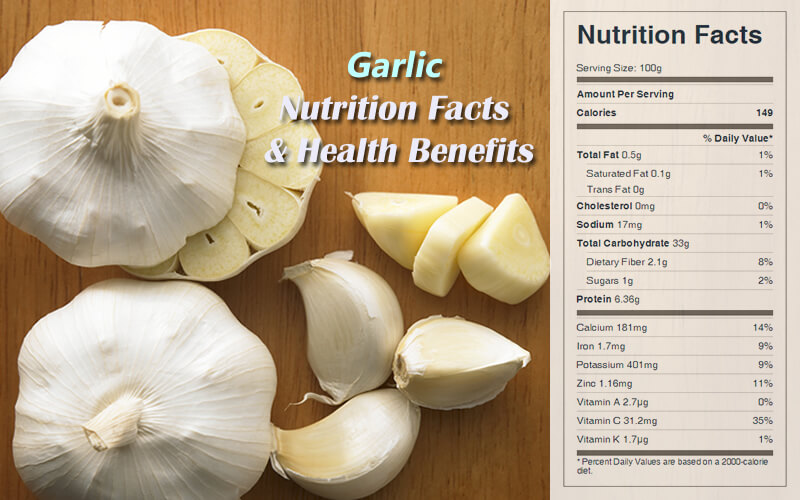Garlic Nutrition Facts & Health Benefits
Garlic has long been used as a seasoning worldwide, with a history of several thousand years of human consumption and use. Garlic is not only a delicious flavoring for food but also has many health-giving properties. Here are the nutrition facts and health benefits of garlic.
Garlic contains several nutrients in rich amounts, including vitamins B6 and C, and the dietary minerals manganese and phosphorus, as well as the dietary minerals calcium, iron, and zinc. Raw garlic is 59% water, 33% carbohydrates, 6% protein, 2% dietary fiber, and less than 1% fat.

Garlic Nutrition Facts Label
Health Benefits of Garlic
Garlic is the most frequently used medicinal plant throughout the world. All sorts of diseases and conditions, including bronchitis, asthma, indigestion, gout, and even athlete's foot, can be helped by garlic. It has antiviral, antibacterial, and antifungal properties, with virtually no side effects, apart from irritation of the gut in some sensitive people.
Garlic supports our mucosal immune system. It helps our microbiome, it has antiinflammatory and immunomodulatory effects, and it is a source of antioxidants.
The main constituent of garlic is alliin, which produces the active form allicin—this is where we get all the health benefits. But first garlic must be disturbed through chewing, smashing, and slicing to generate this production. The phytochemicals responsible for the sharp flavor of garlic are produced when the plant's cells are damaged. When a cell is broken by chopping, chewing, or crushing, enzymes stored in cell vacuoles trigger the breakdown of several sulfur-containing compounds stored in the cell fluids (cytosol). Fresh or crushed garlic yields the sulfur-containing compounds allicin, ajoene, diallyl polysulfides, vinyldithiins, and S-allylcysteine; as well as enzymes, saponins, flavonoids, and Maillard reaction products, which are not sulfur-containing compounds.
Garlic is a member of the onion family, all of whose members are rich in a variety of powerful sulfur-containing compounds, including thiosulfinates, sulfoxides and di-thiins—compounds responsible both for garlic’s characteristically pungent odor and for its health-promoting effects. The sulfur compounds in garlic and other alliums appear to stimulate the production of nitric oxide in the linings of blood vessels, which helps to relax them and may lower blood pressure.
The most exciting discovery about garlic so far, has been its effect on the heart and circulation. Like its close relative the onion, garlic has the ability to thin the blood. It contains the sulfur compound allicin, which helps the body eliminate cholesterol and also reduces the amount of unhealthy fats produced by the liver.
When garlic was given to healthy volunteers who were fed diets rich in fatty foods, garlic reduced blood cholesterol by up to 15 percent. In another study, people with high cholesterol levels who took garlic supplements—but did not otherwise change their diets—reduced their cholesterol levels by an average of 12 percent over a fourmonth period.
Garlic is an excellent source of manganese, a very good source of vitamin B6 and vitamin C, and a good source of selenium, though you probably won’t eat enough of it for it to serve as a significant source of any of these nutrients, garlic is also rich in antioxidants.
Garlic is well known for its immunomodulatory activities and effect on TH1/TH2 balance. When TH1 cells are increased, they result in the production of pro-inflammatory cytokines that are associated with the development of autoimmune disorders. Inflammatory cytokine production in the TH1 cells is significantly reduced in the presence of garlic extract and its active compounds. It’s also been found that garlic can shift the TH1/TH2 balance toward the TH2 type, promoting an antiinflammatory environment. Overall, they modulate inflammatory cytokines, leading to an overall reduction in NFkB activity. Additionally, the bioactive compound ajoene found in garlic was found to increase intestinal IgA, which is the key antibody in our mucosal immune system.
Fructooligosaccharides (FOS) are naturally present in garlic. These fructans serve as prebiotics to our microbiome, helping them flourish and grow. In addition to its anti-inflammatory and immunomodulatory effect, garlic also possesses antioxidant activities. Garlic extract can scavenge reactive oxygen species and enhance cellular antioxidant enzymes such as superoxide dismutase (SOD), catalase, and glutathione peroxidase. Garlic also represents an important source of antioxidants due to the phytochemicals DAS and SAMC.
Now you can see why garlic is so essential to the Mediterranean diet. One to two cloves of garlic a day macerated and chewed will provide you with the compounds needed to gain the beneficial effect. Roasting and grilling garlic doesn’t affect allicin compounds if garlic was chopped first. If you mash after it’s been roasted, you don’t get that benefit.
Health Tips
For maximum flavor and nutritional benefits, always purchase fresh garlic and has unbroken skin. Stay clear of garlic that is soft, shriveled, or moldy, or that has begun to sprout.
Although garlic in flake, powder, or paste form may be more convenient, you will derive less culinary and health benefits from these forms.
It is not necessary to refrigerate garlic. Some people freeze peeled garlic; however, this process reduces its flavor profile and changes its texture.